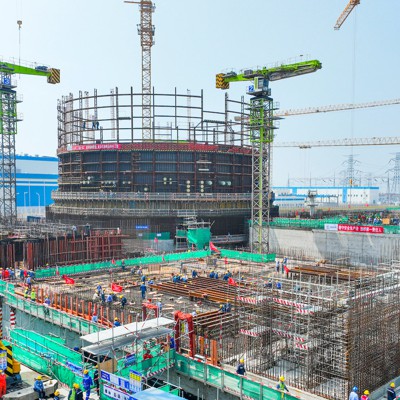Nuclear Power Plant Construction: The Trump Administration's Approach

Table of Contents
Regulatory Reform and Streamlining
A core component of the Trump administration's strategy for boosting nuclear power plant construction was the simplification and acceleration of the regulatory process. The goal was to reduce bureaucratic hurdles and expedite the permitting process, making it more attractive for private investment in new nuclear power plants.
-
Specific Regulatory Changes: The administration focused on streamlining the Nuclear Regulatory Commission's (NRC) processes. This involved efforts to reduce paperwork, improve communication between the NRC and applicants, and expedite the review of licensing applications. While specific legislative changes were limited, the focus shifted towards a more efficient internal operation within the NRC.
-
Impact on Construction Timelines and Costs: The intended impact was a reduction in both the time and cost required to build new nuclear power plants. Faster permitting processes could potentially lead to quicker project completion and lower overall expenses, making nuclear power a more competitive energy source.
-
Examples of Affected Projects: While no specific projects were directly attributed to solely expedited processes under the Trump administration, the general shift towards streamlining could be seen as a positive factor for projects already underway or in the planning stages, like the Vogtle Electric Generating Plant expansion.
-
Industry Response: The industry largely welcomed the efforts to streamline regulations, viewing them as essential for making nuclear power plant construction more economically viable. However, concerns remained about the potential for compromising safety standards in the pursuit of speed.
Financial Incentives and Loan Guarantees
The Trump administration also sought to incentivize nuclear power plant construction through financial support mechanisms. These incentives were designed to encourage private sector investment and reduce the financial risks associated with these large-scale projects.
-
Loan Guarantee Programs: The Department of Energy continued to offer loan guarantees to support the construction of new nuclear reactors. These guarantees reduced the risk for lenders, making it easier for companies to secure financing for their projects. The effectiveness of these programs varied depending on market conditions and investor confidence.
-
Tax Incentives: While no major new tax incentives specifically targeted nuclear power were introduced, existing tax credits and deductions for renewable energy sources could potentially have indirectly benefited nuclear power projects, as they were part of the broader energy strategy.
-
Private Sector Investment: The level of private sector investment in nuclear power plant projects remained limited during this period, partly due to the inherent high capital costs and long construction timelines. Despite government support, securing adequate private financing continued to be a significant challenge.
-
Success of Financial Incentives: The overall success of these financial incentives in stimulating new nuclear power plant construction was modest. While some projects benefited from loan guarantees, the number of new plants initiated remained relatively low compared to the administration's goals.
Focus on Advanced Reactor Technologies
The Trump administration expressed a strong interest in promoting the development and deployment of advanced reactor technologies, particularly small modular reactors (SMRs).
-
Advanced Reactor Technologies: SMRs, smaller and potentially safer than traditional reactors, were viewed as having significant potential for reducing costs and improving safety aspects of nuclear power plant construction. Other advanced reactor designs also received attention, but the focus remained largely on SMRs due to their perceived scalability and adaptability.
-
Government Funding and Support: The administration supported research and development efforts for advanced reactor technologies through various government agencies and programs. Funding aimed at accelerating the design, testing, and deployment of these reactors.
-
Impact on the Future of Nuclear Power Plant Construction: The successful development and deployment of advanced reactors could significantly change the landscape of nuclear power plant construction, potentially leading to more affordable and widely accessible nuclear power. However, this remains a long-term prospect.
-
Challenges: Significant technical, regulatory, and economic challenges remain before advanced reactors become commercially viable and widely deployed. The high cost of research and development, regulatory uncertainties, and a lack of widespread public acceptance pose hurdles to overcome.
Environmental Considerations and Public Opinion
The environmental impact of nuclear power plant construction, along with public perception, played a significant role in shaping the administration's policies.
-
Environmental Benefits and Drawbacks: Nuclear power offers a carbon-free source of electricity, addressing climate change concerns. However, the issue of nuclear waste disposal and the potential for accidents continue to be significant environmental concerns. The administration aimed to highlight the environmental benefits while acknowledging and attempting to address safety concerns.
-
Public Opinion: Public opinion on nuclear energy remains divided, with varying levels of concern regarding safety and waste disposal. The administration sought to promote the environmental benefits and safety measures to increase public acceptance of new nuclear power plant construction.
-
Environmental Regulations: Existing environmental regulations, such as those related to nuclear waste disposal and plant safety, influenced the planning and execution of nuclear power plant projects. The Trump administration's approach aimed to streamline the process without compromising fundamental safety regulations.
-
Nuclear Waste Disposal and Safety: Concerns about the long-term storage of nuclear waste and the potential for accidents remain central to public debate about nuclear power. Addressing these concerns effectively is critical for securing public support for new nuclear power plant construction.
Conclusion
The Trump administration's approach to nuclear power plant construction involved a multi-pronged strategy focusing on regulatory reform, financial incentives, and advanced reactor technologies. While the administration aimed to revitalize the nuclear energy sector and foster energy independence, the long-term success of these policies remains to be seen. Further research is needed to fully assess the lasting impact of these initiatives on the industry. For a deeper dive into the intricacies of nuclear power plant construction, continue your exploration by researching specific projects undertaken during this period. Understanding the complexities of nuclear power plant construction is crucial to navigating the future of energy production.

Featured Posts
-
 Aoc Vs Fox News A Breakdown Of The Recent Trump Criticism
May 10, 2025
Aoc Vs Fox News A Breakdown Of The Recent Trump Criticism
May 10, 2025 -
 Changes To Uk Visa Application Process Nationality Based Restrictions
May 10, 2025
Changes To Uk Visa Application Process Nationality Based Restrictions
May 10, 2025 -
 Harry Styles On That Awful Snl Impression His Honest Response
May 10, 2025
Harry Styles On That Awful Snl Impression His Honest Response
May 10, 2025 -
 Unlocking The Nyt Strands Crossword April 12 2025 Solutions
May 10, 2025
Unlocking The Nyt Strands Crossword April 12 2025 Solutions
May 10, 2025 -
 Mqarnt Adae Fyraty Me Alahly Walerby
May 10, 2025
Mqarnt Adae Fyraty Me Alahly Walerby
May 10, 2025
